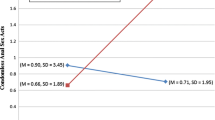Abstract
Boredom is closely aligned with depression, but is understood to be conceptually distinct. Little is known about boredom among active drug users and the potential association with depression and HIV risk. Current IDUs (n = 845) completed a baseline behavioral survey including socio-demographic characteristics, self-reported boredom, depressive symptoms (CESD score), and HIV risk behaviors. One-third of the sample reported high boredom in the past week. In multivariate analysis, those who reported boredom were less likely to be older, African-American, have a main partner, and to be employed at least part-time. Controlling for covariates, those with high boredom were almost five times as likely to report high depressive symptoms. Co-occurrence of boredom and depressive symptoms (28 %) was strongly and independently associated with a range of injection risk behaviors and sex exchange. This study demonstrates the need for more thorough understanding of mental health and HIV risk among urban drug users.
Resumen
El aburrimiento está alineado con la depresión, pero se entiende que es distinto conceptualmente. Poco se sabe sobre el aburrimiento entre los usuarios activos de drogas y la asociación posible con la depresión y el riesgo de VIH. Usuarios de drogas inyectables actuales (n = 845) completó un estudio línea de base, incluyendo preguntas sobre características sociodemográficas, el aburrimiento (auto-reporte), los síntomas depresivos (puntaje CESD), y las conductas de riesgo de VIH. Un tercio de la muestra reportó un puntaje alto del aburrimiento en la última semana. En el análisis multivariado, los que reportaron el aburrimiento eran menos propensas a ser mayores, afro-americanos, tener una pareja principal, y estar empleado por lo menos a tiempo parcial. Controlando las co-variables, los que reportaron el aburrimiento alto eran casi cinco veces más propensas a reportar síntomas de depresión profunda. Co-ocurrencia de aburrimiento y los síntomas depresivos (28 %) se asoció fuertemente e independientemente con una gama de las conductas de riesgo de inyección y el intercambio de sexo. Este estudio ilustra la necesidad de una comprensión más profunda de la salud mental y el riesgo de VIH entre usuarios de drogas urbanos.
Similar content being viewed by others
References
Farmer R, Sundberg ND. Boredom proneness—the development and correlates of a new scale. J Pers Assess. 1986;50:4–17.
Fahlman SA, Mercer KB, Gaskovski P, Eastwood AE, Eastwood JD. Does a lack of life meaning cause boredom? results from psychometric, longitudinal, and experimental analyses. J Soc Clin Psychol. 2009;28:307–40.
Vodanovich SJ, Verner KM, Gilbride TV. Boredom proneness: its relationship to positive and negative affect. Psychol Rep. 1991;69:1139–46.
Sommers J, Vodanovich SJ. Boredom proneness: its relationship to psychological- and physical-health symptoms. J Clin Psychol. 2000;56:149–55.
Melton AM, Schulenberg SE. On the relationship between meaning in life and boredom proneness: examining a logotherapy postulate. Psychol Rep. 2007;101:1016–22.
Fenichel O. On the psychology of boredom. In: Rappaport D, editor. Organization and pathology of thought. New York: Columbia University Press; 1951.
Goodstein E. Experience without qualities: boredom and modernity. Stanford: Stanford University Press; 2005.
Mains D. Neoliberal times: progress, boredom, and shame among young men in urban Ethiopia. Am Ethnol. 2007;34:659–73.
Moran A, Scott PA, Darbyshire P. Existential boredom: the experience of living on haemodialysis therapy. Med Humanit. 2009;35:70–5.
Frankl VE. The unheard cry for meaning. New York: Simon & Schuster; 1978.
Maddi S. The search for meaning. In: Arnold WJ, Page MM, editors. The Nebraska symposium on motivation. Lincoln: University of Nebraska Press; 1970.
McCoy CB, Comerford M, Metsch LR. Employment among chronic drug users at baseline and 6-month follow-up. Subst Use Misuse. 2007;42:1055–67.
Richardson L, Wood E, Zhang R, Montaner J, Tyndall M, Kerr T. Employment among users of a medically supervised safer injection facility. Am J Drug Alcohol Abuse. 2008;34:519–25.
Heidegger M. The fundamental concepts of metaphysics: world, finitude, solitude. Bloomington: Indiana University Press; 1995.
Wegner L, Flisher AJ, Chikobvu P, Lombard C, King G. Leisure boredom and high school dropout in Cape Town. S Afr J Adolesc. 2008;31:421–31.
Ware NC, Wyatt MA, Tugenberg T. Adherence, stereotyping and unequal HIV treatment for active users of illegal drugs. Soc Sci Med. 2005;61:565–76.
Inman A, Kirsh KL, Passik SD. A pilot study to examine the relationship between boredom and spirituality in cancer patients. Palliat Support Care. 2003;1:143–51.
Britton A, Shipley MJ. Bored to death? Int J Epidemiol. 2010;39:370–1.
Radloff LS. The CES-D scale: a self-report depression scale for research in the general population. Appl Psychol Meas. 1977;1:385–401.
van Tilburg WAP, Igou ER. On boredom: lack of challenge and meaning as distinct boredom experiences. Motiv Emot. 2011;. doi:10.1007/s11031-011-9234-9.
Ellis A. Treating the bored client with rational emotive therapy (RET). In: Stern EM, editor. Psychotherapy and the Bored Patient. Binghamton: Haworth Press; 1988.
DeBeck K, Shannon K, Wood E, Li K, Montaner J, Kerr T. Income generating activities of people who inject drugs. Drug Alcohol Depend. 2007;91:50–6.
Vodanovich SJ. Psychometric measures of boredom: a review of the literature. J Psychol. 2003;137:569–95.
Acknowledgments
Support was provided by the National Institute on Drug Abuse (grant no. 1RO1 DA016555).The authors wish to thank the Lighthouse data team for their insight throughout this analysis, the data collection team for their dedicated efforts, and the study participants for their invaluable contributions.
Author information
Authors and Affiliations
Corresponding author
Rights and permissions
About this article
Cite this article
German, D., Latkin, C.A. Boredom, Depressive Symptoms, and HIV Risk Behaviors Among Urban Injection Drug Users. AIDS Behav 16, 2244–2250 (2012). https://doi.org/10.1007/s10461-012-0247-5
Published:
Issue Date:
DOI: https://doi.org/10.1007/s10461-012-0247-5




